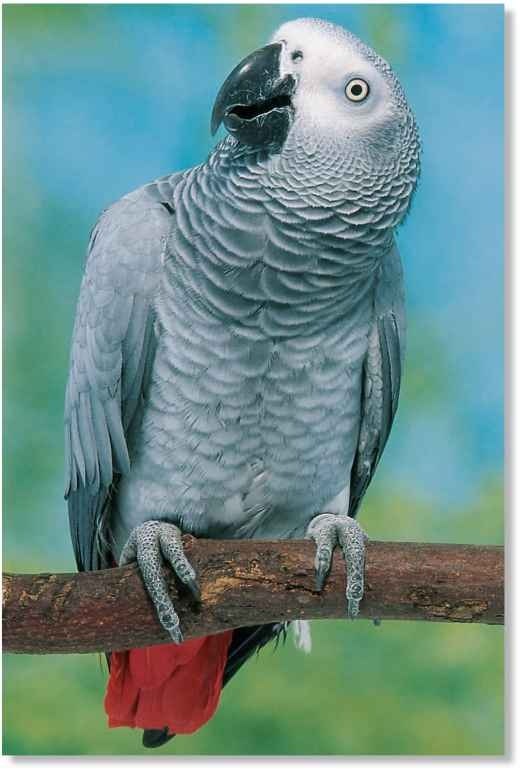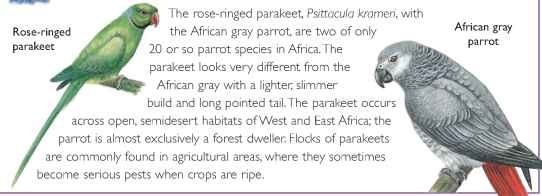ORDER
Psittaciformes
FAMILY
Psittacidae
GENUS & SPECIES
KEY FEATURES
• Expertly extracts seeds and flesh from
all manner of nuts and fruits, using both delicate manipulation and brute force
• Gathers in flocks of hundreds at nightfall to roost high in the rainforest canopy
• Utters a range of screams, shrieks and whistles in the wild, but in captivity may mimic any sound that it hears
WHERE IN THE WORLD?
in a range of forest types, but especially rainforest, in equatorial Africa: from Sierra Leone and Guinea-Bissau to Tanzania and Kenya in the east and south to the \ Congo-Angola border

LIFECYCLE
Although the African gray parrot is one of the most familiar of all cagebirds and is kept in captivity the world over, much of its behavior in the wild remains a mystery.
HABITAT
The African gray parrot lives in dense lowland rainforest and areas of open (secondary) forest, spending nearly all its time in the treetops. At certain times of year, when trees are fruiting, it’ll visit wooded areas of savannah. In the eastern Congo, the parrot frequents upland forest at 6,600′; it also occurs at sea level, in mangrove swamps along the West African coast.
The African gray is an adaptable species and takes advantage of large oil palm plantations in West Africa. The plantations provide nesting sites and a rich and reliable food source: oil palm nuts.
Gray area Primary forest with open glades is the preferred habitat of the African gray, but it also exploits mature secondary forest and oil palm plantations.
CONSERVATION
The African gray parrot isn’t in any immediate danger because it occurs over a wide range. However, in many areas of eastern and central Africa, populations are disappearing because of forest distribution, and although they are bred in captivity for sale, many are still being taken from the wild.
BEHAVIOR
Flying home near dusk, African grays congregate at their roosting sites, usually in tall trees at the forest edge or a clearing in the forest. Where available, they also roost on small islands near the coast or in the middle of a large river, provided there’s plenty of treecover Some roosts may have hundreds, even thousands, of birds.
African grays fly fast, with characteristic shallow and rapid wingbeats. While in flight, they whistle and shriek constantly, creating a huge amount of noise. Although they’re nearly always seen high in the forest canopy, African grays may sometimes visit the ground, since small pieces of quartz have been found in their stomachs. These mineral fragments are probably important in assisting the gizzard, or muscular stomach, to grind down the hard nuts and berries that form the basis of the parrot’s diet.
Tool-use in birds is an uncommon phenomenon, but it has been recorded in the African gray parrot. One bird was seen preening its feathers with a small splinter of wood held in its bill.
FOOD & FEEDING
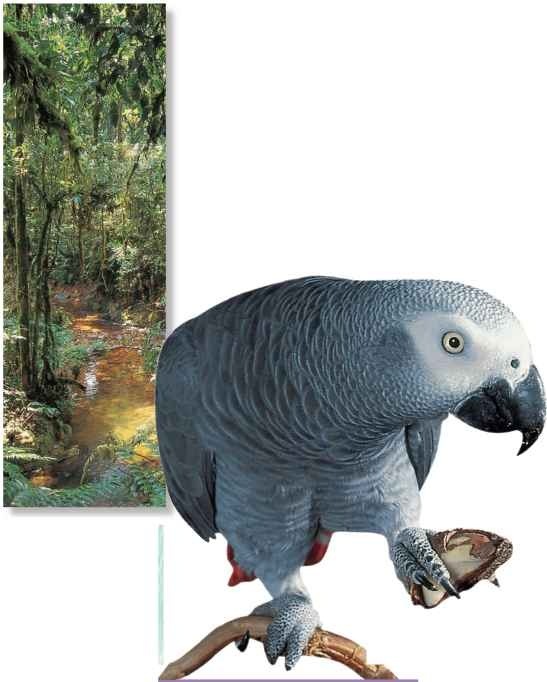
A Fruits of the forest African grays feed using their tongue, bill and feet.
BREEDING
Little is known about the breeding of African grays in the wild, but they generally breed in the dry season.
The nest is usually in a knothole or broken tree limb 70-100′ above ground. The female lays 2-4 white eggs on a bed of wood dust at the bottom of the nest hole and incubates the clutch alone. Once the chicks hatch after about a month, the male brings food while his mate continues to brood them.They fledge at 2-3 months.
▼ Coming into roost Although many aspects of its lifestyle are unknown, the African gray parrot is difficult to miss at nightfall, when it congregates to roost in large and very vocal flocks.

1 Feeding party
Small flocks of African gray parrots gather in the treetops to search for fruits and nuts among the lush foliage.
The frugivorous (fruit-eating) diet of the African gray is varied, comprised of seeds, nuts and berries of many forest trees. The species feeds mainly in the canopy; small parties of parrots clamber noisily on the branches in an energetic quest for ripe fruit.
Once African grays finish feeding in a particular tree, they are reluctant to fly and instead make use of their climbing skills to move to the next feeding place. However; they will fly 3 miles out to sea to offshore islands containing fruiting trees.
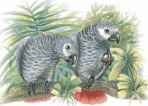
2 Pluck and grip
An African gray parrot can use either its bill or one of its feet to pluck off a ripe nut and then grasp it tightly.
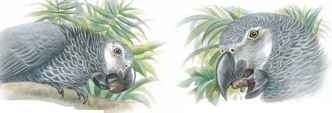
3 Crack open
Applying a tremendous amount of pressure with its powerful bill, the parrot cracks open the nut’s hard casing to reveal a nutritious kernel.
4 Extract and swallow
Using its thick, fleshy tongue, the parrot removes the kernel and manipulates it, before crushing and swallowing it.
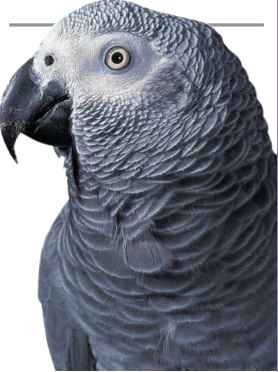
Famous for its ability to mimic sounds, including those produced by objects, such as creaking doors or ringing telephones, the African gray can copy the human voice with remarkable realism. One bird had a “vocabulary” of over 800 words.
• A roost with 5,00010,000 African gray parrots gathers each night at an oil palm plantation in Gabon.
Several hundred pairs of African grays may nest in a loose colony scattered over a wide area. Pairs nest 30-100′ apart, and there’s usually one nest per tree.
^ Breeding season African grays breed from July to January in their tropical range, reflecting the dry to wet seasons.
PROFILE
African Gray Parrot
Dextrous feet and a large, hooked bill double up as the African gray parrot’s versatile feeding and climbing tools in the forest canopy.
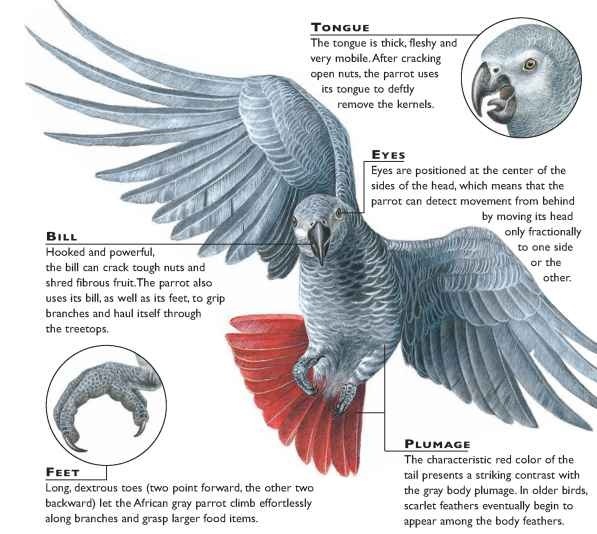
CREATURE COMPARISONS
| Weight | 12-16 oz. |
| Length | 1′ |
| Wingspan | 2′ |
| Sexual Maturity | Unknown |
| Breeding Season | July-January |
| Number of Eggs | 2-4, usually 3 |
| Incubation Period | 3-4 weeks |
| Fledging Period | 10 weeks |
| Breeding Interval | 1 year |
| Typical Diet | Seeds, nuts, fruit; may raid maize crops |
| Lifespan | Unknown in wild; 20 years in captivity |
RELATED SPECIES
• There are 340 species in the parrot family Psittacidae; most are found in tropical and subtropical regions. Close relations in this family include the lories and lorikeets, cockatoos and the cockatiel, macaws, conures, parakeets and amazons. Parrots range from the small lovebirds of Africa to large macaws of South America. These adaptable birds are found in many habitats.
